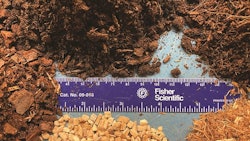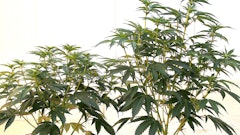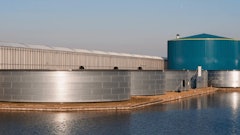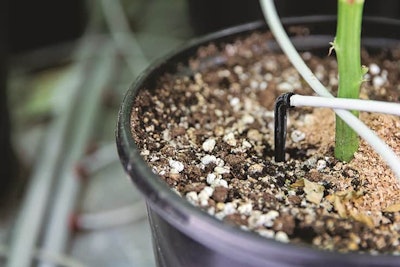

Container growing, in all its variations, remains the bedrock of indoor and greenhouse cannabis operations, as well as many outdoor venues. The media and amendment market is huge, filled with high-performing products that growers may choose from, and for us, media selection comes down to numbers.
Cultivation has a small number of variables that control outcomes. By understanding how these variables affect plant growth, growers can predict how well that media is going to perform in certain applications.
The specific media variables that influence water and nutrient delivery are:
- pH,
- nutrient-holding Cation Exchange Capacity (CEC), water-holding capacity,
- air space percentage, and
- additives.
Each of these characteristics contributes to determining which and how many nutrient atoms are concentrated in the water solution in the few millimeters surrounding a root. This is the rhizosphere, where the action is in nutrient and water uptake.
Pick and Stick: How Do You Know When You Have the Right Media?
Plants can grow without media, so there really is no “right media.” Growth is controlled by water and nutrients, and media performs the task of holding them close to the roots. With proper care and feeding, plants will grow in anything from sand to crushed lava rock. Regardless of the medium, examination of its technical characteristics tells us whether it is suitable for use in any given cultivation scheme. Even more important than making the initial choice, though, is the patience to stick with that choice and learn to work with it.
Each medium has pros and cons, so don’t look for the perfect one. Search for a medium that fits your overall scheme, then:
- Perfect the techniques that produce the biggest yields; Lock them down in standard operating procedures (SOPs); and
- Stick with the media until/unless a significantly more efficient system is found.
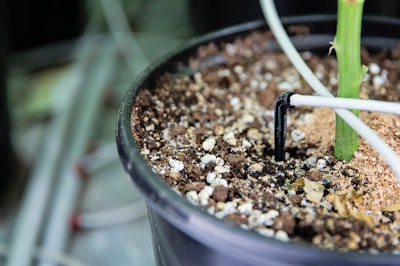
For Delivery: What’s the Best Way to Get Water to the Plants?
“Any way you can afford to” seems to be the answer for a lot of growers. However, following some simple guidelines can better answer that question.
A low-water-holding medium probably isn’t a good choice with hand-watering, if that means multiple daily waterings, but that same media can work perfectly fine with a recirculating nutrient-distribution system.
Peat and some coco media can hold large amounts of water and are tolerant of inconsistent watering. Out-of-the-bag peat moss mixes weigh about 9 pounds per cubic foot and as much as 55 pounds when fully saturated. Plants can go a long time between watering with that kind of water-holding capacity.
Rockwool and other synthetic media also hold a lot of water, so rockwool blocks/slabs in a sump tray is just as efficient as a container of peat moss for delivering water throughout several days.
The Nutrient Reservoir: Is a High CEC Good or Bad?
The Cation Exchange Capacity (CEC) indicates how well a media can attract and hold cations, or positively charged ions, like calcium, magnesium, hydrogen, potassium, iron, sulfate and ammonium.
While positively charged ammoniacal nitrogen ions (NH4+) accumulate on high-CEC media, negatively charged nitrate nitrogen ions (NO3-) are repelled and easily flushed out of the container, which is why so many retail container-plant nutrients are ammonium based. This ensures a reservoir of nitrogen the plants can draw from during their journey to their retail locations. If high-CEC media is used with ammoniacal nitrogen, the media’s pH will decrease over time. Growers need to make sure to manage media pH so that it does not drop too low.
If nitrate-nitrogen fertilizers are used with peat and coco (most popular concentrated-nutrient cannabis products deliver nitrate nitrogen), pH will generally rise over time, so growers must make sure the pH doesn’t rise too much.
If nutrients are applied to a high-CEC peat or coco media in excess of plant needs over an eight-week flower period, a significant accumulation of nutrients can occur in peat/coco mediums that can affect water uptake and potentially damage the roots. Electrical-conductivity (EC) monitoring and corrective flushing are the tools to prevent or correct excessively high ECs.
Rockwool has no appreciable capability to attract nutrient ions, and, therefore, is treated almost like an inert substance in the growing equation. pH excursions are what growers need to watch for with rockwool and even low-CEC coco medias.
Balancing the Highs and Lows: Which Media Is Best for pH Management?
Growers generally want their root areas at a pH between 5.5 to 6.5. Peat moss mixes use lime amendments to raise peat’s naturally low pH. When wetted, the lime amendments dissolve and neutralize the peat’s natural acidity. The lime also acts as a buffer against pH change by providing relatively steady pH throughout the growth cycle.
Coco coir does not need liming to raise its pH, which is naturally around 6. The absence of the liming in many coco products means there is no pH buffering, so coco growers may want to monitor media pH closely until stability is demonstrated over a significant time-frame. Some coco products come with pH-buffering amendments to address this problem.
Rockwool has a natural pH around 7 and provides no buffering so that pH can only be controlled via the nutrient-solution pH, which may be influenced by pH up-and-down treatments.
Give ’Em Air: How Much Air Do Plants Need?
Properly aerated media delivers all the oxygen a plant needs, and peat and coco media provide about 17-percent volume air space if containers are not packed out by an overzealous transplant person. We have seen coco products with textures that range from powder to what looks strikingly like bark landscape mulch, so think about air space before purchasing.
Simulated Soil: Which Media Works Best with Organic Methods?
We refer to organic grower mixes as “simulated soils” because they attempt to simulate the nutrient breakdown and delivery mechanisms of natural soils. The pH, density, water-holding capacity, CEC and nutrient content of simulated soils depend on the relative amounts of constituent ingredients, which may include peat/coco media or compost. Make up a sample batch and send it off to the lab to get a fingerprint of the mixture that can be used to compare future batches.
Safe Harbor: Which Media Amendments Are Best for Pest and Contamination Management?
As noted above, peat and coco are organic materials, so they come with the risk of being a safe harbor for biological villains. Engineered products have a very good track record on product cleanliness, but it is very easy for a powdery mildew spore or spider mite egg to hitch a ride on these products and appear on the crops.
Powdery mildew can ride into a facility on rockwool blocks just as easily as it can arrive on organic media, but rockwool is never reused, so no residual issues exist with it. Just place it in the trash. Once organic media is used, all manner of disease and pests may be present, and we do not recommend reusing it unless it is subjected to a sterilization process, such a steaming, to keep the risk from reuse to a minimum.
Fungicides are added to many grow mixes to help with disease resistance. Mycorrhizae are also common amendments that improve nutrient uptake and act as a disease shield. These ingredients can be purchased and added to anyone’s media mixture. Mycorrhizae are adapted to a fine matrix of soils that support mycorrhizal hyphae, so a crushed half-inch lava rock medium is not likely to be the best host for mycorrhizae.
Assessing Media Performance: What Data Is Important?
Regardless which media is chosen, make sure to have some analytical eyes and ears handy. Labs provide great, detailed information, but EC and pH meters can provide most of what growers need to know to manage their nutrients without labs. Versions of these meters for “direct stick” have probes that can be stuck into the media to quickly measure characteristics near the roots. The “direct stick” meters allow growers to take many measurements in the time it takes to run one leachate runoff test.
Reality Check: More Math?
The fact that media has volume, mass and cost means other realities must be faced in media choice. For example, the grower in Hawaii may love coco or peat products, but the cost of shipping them to the islands might be tough to swallow; if that is the case, shifting to large rockwool blocks or slabs may make more sense.
Media waste streams are prodigious, and waste disposal is problematic. Simple arithmetic involving the container size, the number of plants and a harvest schedule provides the number of cubic feet of this by-product for which a grower needs to account.
Look at Everything
Media influences water and nutrient delivery, but it is also involved in answering questions from how dense plants can be packed as well as how big a lift truck to buy and how often the roll-off out back needs to be emptied. Going through the math, all of it, is the pathway to media cost effectiveness. So do your homework.








